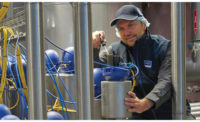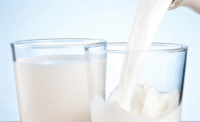Customers of Tetra Pak who come to the company’s North American headquarters in Denton, Texas, to create new products or improve upon existing packaging or beverage formulations usually spend a couple days in the “ideation room” hashing through concepts. Then they test those concepts in the company’s 27-year-old, recently renovated pilot plant.
While in the ideation room, customers brainstorm with Tetra Pak’s multidisciplinary team to get to the heart of what they need and what their challenges are, said Julia Sotera, director of marketing services for Tetra Pak Americas. She spoke with Dairy Foods earlier this year at a daylong media event.
“Here it’s like the behind-the-scenes of a film,” Sotera said. “We want to provoke the right side of the brain.”
An aseptic plant fills the gap for processors
Once package designs and/or formulations are cooked up, the pilot plant bridges the gap between idea and commercialization, serving essentially as a test kitchen, Sotera said. The plant provides aseptic capability, keeping dairy and beverage products shelf-stable at room temperature for as long as necessary for research purposes.
From the customer’s point of view, she said, “It would be very disruptive to stop my factory to test products. Some customers don’t have pilot plants at all, and those who do, don’t necessarily have the aseptic capability. The pilot plant fills this gap.”
Before the plant was refurbished with all new equipment in the past couple of years — and before Tetra Pak hired a food chemist to bring more scientific weight to the formulations — the pilot plant wasn’t necessarily part of the process, Sotera said.
“We used to have the pilot plant standing alone, and customers would knock on the door and ask, ‘Can I use this?’ ” she said. “It’s been an evolution of things that we prove delivers the value.”
Small-batch test runs in the pilot plant
During a brief tour of the pilot plant, manager Alex Croy pointed out that the plant’s blending and processing capabilities are geared toward small-scale, quick and efficient runs. The standard batch size is about 100 gallons, one-tenth or less what a large manufacturing facility would run.
“We can do multiple products in a day,” he said. “We can be very, very efficient so our customers can test a lot of products, which they can take to their consumer research and decide what to scale up.”
The plant contains mixing equipment not unlike a giant-sized Kitchen Aid mixer and thermal processing tanks that deliver the heat treatment to kill off bacteria and make the product shelf-stable, Croy said. “It will be safe forever, until the consumers opens the cap because then the outside environment can get into the product,” he said.
Filling machines sterilize the packaging material and wrap it around the product in layers of ink, paper, plastic and very thin aluminum that acts as an oxygen barrier, Croy said. “This package is a plastic bag inside of a metal can inside of a cardboard box,” he said.
The machines inside the plant are made to run 20 hours a day, seven days a week, but because of their purpose, they are only used about 4 minutes at a time, about five times a day, Croy said. “It’s like a car you never drive,” he said.
The machines can deliver between 7,500 and 24,000 packages an hour, with the slower-speed machines more flexible because they can be converted to different-sized packages midway through a run, Croy said. Once a customer finishes a pilot run, products are stacked on a palette and shipped wherever they need to go, whether a trade show or a focus group.
“We get customers all the way from one-person startups … to the Nestles and Cokes and Pepsis, the 800-pound industry titans,” Croy said. “They all come through here, and they all have different expectations, different product types, different ways of doing business, different demands. So it’s kind of fun.”









